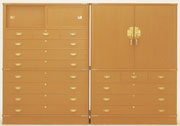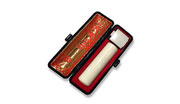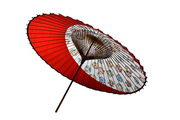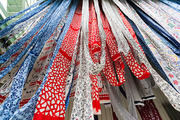Ibaraki and more
- Sort by
- Popularity
- Name
-
Koshu lacquered deer leather Koshu inden
- Other crafts
- Yamanashi

Koshu lacquered deer leather (called Koshu inden in Japanese) is a unique style of leathercraft that was developed in the city of Kofu, Yamanashi prefecture. Koshu lacquered deer leather is unique because of its combination of deer leather and uru…
View more
-
Mino ware Mino yaki
- Ceramic
- Gifu

Mino ware (called Mino yaki in Japanese) is a ceramic ware produced in the Tono area of Gifu prefecture. It has a long history and tradition but has adapted to modern life style. A notable feature of Mino ware is its wide variety of pottery. Mino …
View more
-
Tobe ware Tobe yaki
- Ceramic
- Ehime

Tobe ware (called Tobe yaki in Japanese) is a form of ceramic ware produced around the town of Tobe in Iyo district of Ehime prefecture. Production began in the middle of the Edo period (1603-1868) and it was registered as a traditional craft by t…
View more
-
Yuki tsumugi silk Yuki tsumugi
- Woven textiles
- Ibaraki

Yuki tsumugi silk is produced principally in the reaches of the Kinugawa River that straddles the Ibaraki and Tochigi prefectures. The Japanese name Yuki tsumugi comes from the name of a feudal lord during the Kamakura period (1185-1333), Yuki. Al…
View more
-
Kasama ware Kasama yaki
- Ceramic
- Ibaraki

Kasama ware (called Kasami yaki in Japanese) is a form of porcelain produced in the area around the city of Kasama in Ibaraki prefecture. This porcelain has long been considered a traditional souvenir of visiting Kasama Inari shrine (one of Japan&…
View more
-
Mino traditional Japanese paper Mino washi
- Traditional Japanese paper
- Gifu

Mino washi is a type of Japanese paper made in Gifu prefecture. Washi is made from paper mulberry which is a plant that grows in the city of Mino, a place of abundant forests. Ancient manuscripts in the Shosoin Repository* indicate the history of …
View more
-
Gifu lanterns Gifu chochin
- Other crafts
- Gifu

Gifu lanterns (called Gifu chochin in Japanese) are produced in the city of Gifu, Gifu prefecture and have a history of over three hundred years. In 1995, their high level of craftsmanship was recognized with a designation as a National Traditiona…
View more
-
Shodai ware Shodai yaki
- Ceramic
- Kumamoto

Shodai ware (called Shodai yaki in Japanese) is a form of pottery baked mainly in the northern part of Kumamoto prefecture. This craft is distinguishable because of its simple texture, strong form, and bold design, which is due to the pouring meth…
View more
-
Yamaga lanterns Yamaga toro
- Other crafts
- Kumamoto

Yamaga toro are lanterns made of washi (traditional Japanese paper) produced in the area surrounding the city of Yamaga, Kumamoto prefecture. For the Yamaga Lantern Festival, an annual summer event, this craft is worn by one thousand dancing women…
View more
-
Ichii woodcarvings Ichii itto bori
- Wood, bamboo crafts
- Gifu

Ichii woodcarvings (called Ichii itto bori in Japanese) are produced in the Hida region of Gifu prefecture, and made only from the wood of ichii (Japanese yew), the prefectural tree of Gifu. The ichii tree gets its name from a scepter made of Japa…
View more
-
Sakai cutlery Sakai uchihamono
- Metal works
- Osaka

Sakai traditional blades are hammer-forged knives produced in the cities of Osaka and Sakai, Osaka prefecture. To achieve both strength and cutting quality, this craft is made by combining soft iron and steel. This craft is forged to have a sharp…
View more
-
Hida-shunkei lacquerware Hida shunkei
- Lacquerware
- Gifu

Hida-shunkei lacquerware is produced around the city of Takayama in Gifu prefecture. The name is said to come from the fact that the articles produced initially had a similar coloring to Hishunkei tea containers. This craft is notable for having …
View more
-
Osaka naniwa pewterware Osaka naniwa suzuki
- Metal works
- Osaka

Osaka naniwa pewterware (called Osaka naniwa suzuki in Japanese) is a metalwork produced in and around the city of Osaka, Osaka prefecture. In the past, tin mined in Japan was used, but today it is imported mainly from Thailand and Indonesia. This…
View more
-
Osaka Buddhist altar Osaka butsudan
- Household Buddhist altars
- Osaka

Osaka Buddhist altars (called Osaka butsudan in Japanese) are produced in the cities of Osaka, Yao, Higashiosaka, Sakai, and Kishiwada in Osaka prefecture. Along with the standard lacquer-painted, gold-leafed altars, this region is also known for …
View more
-
Ozu traditional Japanese paper Ozu washi
- Traditional Japanese paper
- Ehime

Ozu traditional Japanese paper (called Ozu washi in Japanese) is a handmade paper made in the town of Uchiko, Ehime prefecture. The history of papermaking of Ozu washi dates back to the Heian period (794-1185), and the current style of Ozu washi e…
View more
-
Amakusa ceramics Amakusa tojiki
- Ceramic
- Kumamoto

Amakusa ware (called Amakusa Tojiki in Japanese) is a form of pottery or porcelain baked in the Amakusa region of Kumamoto prefecture. The name was newly applied when the craft was designated as a national traditional craft. In Amakusa, where high…
View more
-
Osaka carved wooden panel Osaka ranma
- Wood, bamboo crafts
- Osaka

Osaka Transoms (called Osaka Ranma in Japanese) are transoms produced in and around the cities of Osaka, Kishiwada, and Suita in Osaka prefecture. In a Japanese-style house, transoms are wooden panels attached between the ceilings and lintels of t…
View more
-
Nibutani carved wooden tray Nibutani ita
- Wood, bamboo crafts
- Hokkaido

Nibutani Carved Wooden Trays (called Nibutani ita in Japanese) are produced in Biratori, Hokkaido. The origin of the town name, is an Ainu language word for cliff, pirauturu. This craft is known for its patterns like a spiral pattern called moreun…
View more
-
Koshu crystal and precious stones carving Koshu suisho kiseki zaiku
- Semiprecious stone craftwork
- Yamanashi

Koshu crystal and precious stones carving called Koshu Suisho Kiseki zaiku in Japanese, are crystal and precious gemstone carvings produced in the city of Kofu, Yamanashi prefecture. Using traditional methods, natural gemstones are carefully cut, …
View more
-
Nibutani bark cloth Nibutani attoushi
- Woven textiles
- Hokkaido

Nibutani Bark Cloth (called Nibutani-attushi in Japanese) is a bark fiber fabric produced in the region surrounding the the town of Biratori, Hokkaido. The term Nibutani originates from niputai which is an Ainu (indigenous people of north Japan) l…
View more
-
Higo inlays Higo zogan
- Metal works
- Kumamoto

Higo Zogan is inlaid metal work produced in Kumamoto, Kumamoto prefecture. This craft was formerly used to adorn the gun barrels or sword guards of samurai. Today, however, the skills are used to make personal accessories or interior ornaments. Th…
View more
-
Osaka karaki wood joinery Osaka karaki sashimono
- Wood, bamboo crafts
- Osaka

Osaka Karaki Wood Joinery, called Osaka Karaki Sashimono in Japanese, are wooden articles manufactured in several cities of Osaka Prefecture. Karaki is wood from trees mainly grown in Southeast Asia, and include rosewood, ebony, Chinese quince, an…
View more
-
Makabe stone lanterns Makabe ishidoro
- Stonework
- Ibaraki

Makabe Ishitoro is the Japanese name for Makabe stone lanterns produced around the town of Makabe in the Ibaraki Prefecture. Production of this traditional craftwork started during the Kamakura period (1185-1333). The stone industry in the Makabe …
View more
-
Osaka bamboo screens Osaka kongo sudare
- Wood, bamboo crafts
- Osaka

Osaka Kongo Sudare are bamboo blinds produced in the cities of Tondabayashi and Kawachi-Nagano in Osaka Prefecture. Tondabayashi City lies at the foot of Mt. Kongo, the highest mountain in Osaka, and good quality Japanese timber bamboo growing nat…
View more
-
Osaka-senshu traditional paulownia chest Osaka senshu kiri tansu
- Wood, bamboo crafts
- Osaka

Osaka Senshu Kiri Tansu are wooden chests of drawers made in and around Kishiwada City and Sakai City, Osaka Prefecture. They are made from Paulownia wood, much appreciated for its durability, excellent moisture barrier properties and fire resista…
View more
-
Koshu hand-carved seals Koshu tebori insho
- Other crafts
- Yamanashi

Koshu Tebori Insho are hand-engraved personal signature stamps produced in Kofu City and Fujiyoshida City of Yamanashi Prefecture. Bringing together all of Yamanashi’s engravers, dealers, and material producers, this local industry is unlike those…
View more
-
Gifu Japanese Umbrellas Gifu Wagasa
- Other crafts
- Gifu

Japanese umbrellas are not only used on rainy days or as parasols, but there are also umbrellas used for dancing and larger parasols called nodategasa used for outdoor tea ceremonies. They become very slim and delicate when they are closed, and t…
View more
-
Naniwa Honzome Hand Dyeing Naniwa honzome
- Dyed textiles
- Osaka

Naniwa Honzome Hand Dyeing is a traditional Japanese dyeing method, of which products are mainly produced in Sakai and Kashiwara, Osaka Prefecture. Osaka was a large producing center of Japanese hand towels called tenugui since the Edo period (160…
View more
- 1































































































































































































































































































